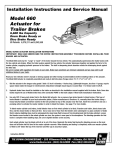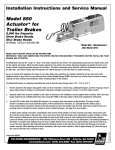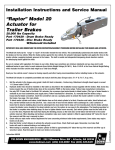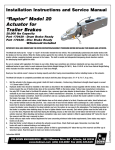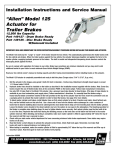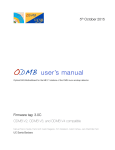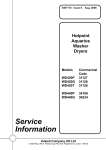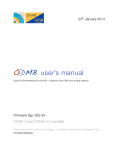Download Drum Brake Owners Manual - Northern Tool + Equipment
Transcript
Drum Brake Owners Manual Drum Brake Information If your trailer is equipped with hydraulic drum brakes, the brakes are activated by the surge actuator/coupler located on the front end of the trailer tongue. When the tow vehicle stops, the trailer pushes into the tow vehicle, compressing the master cylinder that is located inside the actuator. The master cylinder forces brake fluid to the drum brakes. Inside each drum brake is a wheel cylinder that expands with the surge of brake fluid, pushing the brake shoes against the inside of the brake drum. Drum brakes must be periodically adjusted. Recommended service intervals are after the first 500 miles and then every 1000 miles. Drum brakes also must be flushed when submerged in salt water or towed in road conditions where salting of the roads is done to improve driving conditions. Many marine and trailer accessory companies offer drum brake flush kits. If you use your trailer in these conditions, it is recommended that you install a flush kit, if your trailer did not come equipped with the flush kit. Model 660 Drum Brake Actuator Part #82400 Single Axle Brake Line Kit Part #80326 Trailer Brake Flush Kit Part #81107 Drum Brake Installation 1. Using an adequate capacity floor or scissors jack, raise the side of the trailer. Block the wheels opposite the side being worked on both front and rear so that the trailer cannot roll. DO NOT rely on the jack as the only means of support. Always support the trailer with adequate capacity support stands. UNDER NO CIRCUMSTANCES IS THE TRAILER TO BE SUPPORTED BY THE TONGUE JACK WHILE BEING RAISED AT THE WHEELS! NOTE: Check under frames for brake lines BEFORE lifting. DO NOT position jack in areas that may damage brake lines, etc. NOTE: Tandem and tri-axle trailers should be jacked on the frame between the wheels, or directly under the axle within 8” of the backside of the tire. B. Single axle trailers can be lifted on the frame just behind the axle or directly under the axle within 8” of the backside of the tire (if lifting at the axle). 2. Remove the wheels 3. Remove the dust cap. 4. If your spindle has a tang washer, pull up on the tab so you can unlock and remove the castle nut. If you have a cotter pin, pull it out and remove the castle nut. 5. Remove the hub. It may be helpful to release tension to the brakes pads by backing off the star adjuster. 6. Disconnect the hydraulic brake lines or the electric brake wires. 7. Remove the backing plate by removing the 4 or 5 mounting bolts holding the brake to the brake flange. Clean the spindle and brake flange. 8. Determine which side the brakes go on. The brakes should be labeled “L” for Drivers side & “R” for Passenger side. If the labels have been removed, simply look at the master cylinder on top(for hydraulic brakes), the piston inside the master cylinder will always point forward. For Electric brakes look at the magnet bracket, the curved bracket should point forward with the open end towards the back. See next page. 2 Drum Brake Installation Hydraulic Brake “Left” Drivers Side Hydraulic Brake “Right” Passengers Side Electric Brake “Left” Drivers Side Electric Brake “Right” Passengers Side 9. Mount the brake assembly to the brake flange with the mounting bolts. Mounting bolts should torque to 40 fps. 10.Inspect the original hub. Check the seal & bearings for wear. if there is any doubt whatsoever, go ahead and replace the seal and bearings and repack with fresh grease. 11.Reinstall the hub. Push the hub back into place. Make sure your bearings are seated. 12.Install the washer and use a new tang washer. It is always a good idea to replace it, just like a cotter pin. 13.Reinstall a castle nut, run it down until it stops. Rock the hub back and forth a little bit. Spin the hub a little bit. Make sure everything is seated. Run the castle nut down until it stops and then back off to the next notch, whichever you can use one of the tabs on the tang washer bend it down into the castle nut. Drum Brake Installation 14.Install the dust cap. 15.Reattach electric brake wires or reconnect hydraulic brake lines and follow instructions for hydraulic bleeding.. Adjusting The Brakes 16.With trailer wheel off the ground and tire mounted. Remove the rubber access hole plugs from the rear of the brake backing plate. 17.Inserting a brake spoon or flat screwdriver through the access hole(s), tighten the star adjuster while rotating the wheel in the forward direction. NOTE: Always spin wheel in the forward direction as if the trailer was traveling forward on the road. Tighten the star adjuster until the wheel reaches a point where the brake shoes start to engage. 18.Loosen the star adjustor one click at a time while turning the wheel in a forward rotation. Continue adjusting one click at a time until the wheel rotates with little effort. 19.Replace the rubber access hole plugs. 20.Repeat this procedure for all braking wheels. Bleeding the Brake System - Hydraulic Drum Bakes Only Use only DOT-3 heavy duty fluid in the actuator. Do not re-use brake fluid. Do not use any other type of brake fluid other than DOT-3. If pressure bleeding equipment is available, follow the manufacturer’s instructions in bleeding the system. These types of brake bleeders are available at your local automotive supply. Manually Bleeding, Pumping the Actuator: Insert a heavy-duty flat blade screwdriver into the hole provided on top of the actuator near the front. Insert the screwdriver and catch the bleeding latch bracket and with a pumping action tilt the screwdriver front to back in a rocking motion to activate the master cylinder in order to bleed the brakes. To bleed master cylinder and brakes, install bleeder hose on first wheel cylinder to be bled; if tandem axle trailer, bleed furthermost axle first, and the furthermost brake on that axle first. Loosen the bleeder screw located in the wheel cylinder one turn, the system is now open to the atmosphere. Attach a loose end of a hose from the bleeder valve with the other end submerged in a glass container of brake fluid. While pumping the actuator watch and observe the bubbling (hose must be submerged into clean brake fluid to keep air from traveling back into the brake cylinder). The bleeding operation for that brake is complete when bubbling stops. Be sure to tighten bleeder screw securely. Each wheel cylinder must be bleed until all air is out of the lines. Replenish the brake fluid during the bleeding process so the level does not fall below half full level in the master cylinder reservoir. When bleeding and testing is completed, make sure master cylinder is filled the reservoir and filler cap is securely in place. When using drum or disc brakes on tandem axle trailers, both axles must be installed with brakes, Failure to install brakes on both axles will result in loss of braking performance, overheating of brakes & wheel hub, and significantly reduce brake pad life. WARNING Brakes should always be flushed with fresh water after using trailer in corrosive conditions. This includes salt water, fertilizers and other corrosive materials. Before storing trailer remove brakes and clean thoroughly. It is also wise to repack the bearings at the same time. WARNING DO NOT REUSE BRAKE FLUID. Always use fresh DOT 3 fluid from a fresh container. Failure to maintain proper levels of fluid will cause brake failure. Electric Drum Brake Information Electric brakes are activated by a brake controller located in the tow vehicle. This is generally an accessory that must be purchased separately. Please research before buying. Some controllers work better with different brand tow vehicles. Electric drum brakes are not recommended for marine applications Electric brakes are individually adjusted in the same way the hydraulic drum brakes are adjusted that is covered in this manual. The electric drum brakes work by an electrical current going to the brakes and activating a magnet. The magnet is then attracted to the inside wall of the drum hub. This drags the magnet and pushes the brake shoes out against the drum hub. The brake controller is generally adjustable to regulate the amount of current given to the magnets/drum brakes. This adjustment controls the amount of braking force applied. Wires are connected to the brakes by one of two methods: 1. Plug in wires 2. Twist wires with a wire cap cover. There is not a specified positive/negative connection at the brakes Hydraulic Drum Brake Trouble Shooting Symptoms Possible Cause Noise or brake chatter Improper brake adjustment. Brake fluid or grease on lining. Improperly adjusted or worn wheel bearing. Drum out of round. Dirt on drum or lining surface. Dust in rivet holes. Lining glazed or worn. Scored drum. Loose backing plate. Weak or broken return springs. Only one brake is activating Improper brake adjustment. (see brake adjustment) Brake line is restricted. Improperly adjusted or worn wheel bearing. Drum out of round. Loose backing plate. Faulty wheel cylinder. Weak or broken shoe return spring. Glazed or worn lining. Loose lining. Air in hydraulic system. Dirty brake fluid. All brakes drag Brakes do not apply Faulty actuator. Mechanical resistance at actuator or shoes. Brake lines restricted. Dirty brake fluid. Faulty back up solenoid (if used). Leaking wheel cylinder Check and replace wheel cylinder and bleed brakes. Leaks or insufficient brake fluid. Air in hydraulic system. Improper brake adjustment. Faulty actuator. Lining glazed or worn. Brake fluid or grease on lining. Dirty brake fluid. Seized wheel cylinder piston Check and replace wheel cylinder and bleed brakes. Return Spring Shoe Pin Upper Return Spring Adjuster Shim Hydraulic Drum Brake Parts Shoe Pin Return Spring Adjuster Shim Cylinder Assembly ft Brake Pad Return eeUpper Backing) Spring lugs Hold Down Spring Assembly Retainer Washer Rear Upper Return Spring Hold Down Spring Assembly Hold Down Spring Assembly Dust Plugs Wheel Ad Lower Ret Actuat Primary Pad Shoe Pin Right Brake Pad Dust Plugs (Free Backing) Wheel Adjuster Assembly Lower Return Spring Hold Down Spring Assembly Left Brake Pad (Free Backing) Rear Upper Return Spring Right Brake Pad (Free Backing) el Adjuster Assembly r Return Spring Left Brake Pad (Free Backing) Wheel Cylinder Assembly Hold Down Spring Rear Upper Upper Return Spring Return Spring Assembly Hold Down Spring Assemb Right Brake Pad (Free Backing) Wheel Adjuster Assembly Magnet Sprin Lower Return Spring Dust Plugs Drum Wheel Cylinder Kit for 10” & 12” Brakes includes; LH & RH Wheel Cylinder and mounting screws Part #80994 Drum Replacement Parts Kit (Free backing & Uni-Servo) includes all parts shown, excluding pads, back plate and wheel cylinder 10” Parts Kit Part #81096 12” Parts Kit Part #81095 Actu Brake Pad Replacement Kits Primary Pad Kits include brake pad sets for left and right side brakes 7” Free backing Shoe (lining) Kit Part #81113 10” Free backing Shoe (lining) Kit Part #81108 12” Free backing Shoe (lining) Kit Part #81109 Hold Down Spring Assemb Electric Drum Brake Trouble Shooting Symptoms Possible Cause Noise or brake chatter Improper brake adjustment. Oil or grease on lining. Improperly adjusted or worn wheel bearing. Drum out of round. Dirt on drum or magnet surface. Dust in rivet holes. Lining glazed or worn. Scored drum. Loose backing plate. Weak or broken return springs. Only one brake is activating Improper brake adjustment. (see brake adjustment) Improperly adjusted or worn wheel bearing. Drum out of round. Loose backing plate. Weak or broken shoe return spring. Glazed or worn lining. Loose lining. Bad connection at tow vehicle. Broken or disconnected wire. Bad magnet. Dirt or grease inside hub surface. All brakes drag Brakes do not apply Faulty or improperly adjusted brake controller. Improperly wired brake connection. Mechanical resistance at actuator or shoes. Faulty brake controller. Improperly adjusted brake controller. Brake wires not connected to tow vehicle. Bad Magnets. Improper brake adjustment. Lining glazed or worn. Dirt or grease inside hub surface. Damaged wiring. Electric Drum Brake Parts Actuating Cam Return Spring Actuating Cam Return Spring Upper Return Upper Return Spring ctuating Level Spring Actuating Level Arm Arm Primary Pad wn HoldReturn Down Spring Spring ActuatingAssembly Level Arm Hold Down Spring Assembly embly Primary Pad U Sp Secondary Pad Dust Plugs Brake Adjuster Magnet & Spring Hold Down Spring Assembly Secondary Pad Dust Plugs gnet & pring Actuating Cam Brake Adjuster Lower Return Spring Lower Return Spring Hold Down Spring Assembly Hold Sprin Asse Actuating Cam S Spring/Adjuster Replacement Kit Dust Plugs for 10” & 12” brakes Part #82075 Brake Adjust Magnet & Spring Lower Return Upper Return Spring Hold Down Spring Assembly Secondary Pad Dust Plugs Magnet, Wiring & Spring Assembly 10” Magnet Assembly Part #82078 12” Magnet Assembly Part #82079 Upper Return Spring Brake Adjuster Actuating Level Lower Return Spring Arm Primary Pad own ng sembly Actuating Level Arm Pad Replacement Kits 10” Electric Shoe (lining) Kit 12” Electric Shoe (lining) Kit Hold Down Spring Primary Pad UpperAssembly Return Actuating Level Arm Hold Down Spring Assembly Upper Return Spring Part #82076 Part #82077 Hold Down Spring Assembly TIE DOWN ENGINEERING 255 Villanova Drive SW, Atlanta, GA 30336 (404) 344-0000 • Fax (404) 349-0401 © 2011 TIE DOWN ENGINEERING, ALL RIGHTS RESERVED Instruction Manual #08095 0706011,C934 Drum Brake Owners Manual Installation Instructions and Service Manual Model 66/660* Actuator for Trailer Brakes 6,600 lbs Capacity Drum Brake Ready or Disc Brake Ready US Patent No. 6,375,211 *Model 660 - Manufactured after March 2012 MODEL 66 ACTUATOR INSTALLATION INSTRUCTIONS IMPORTANT: READ AND UNDERSTAND THE ENTIRE INSTRUCTION/ASSEMBLY PROCEDURE BEFORE INSTALLING YOUR BRAKES AND ACTUATOR. The Model 66/660 works by the “surge” or “push” of the trailer toward the tow vehicle. This automatically synchronizes the trailer brakes with the tow vehicle axle brakes. When the trailer pushes against the tow vehicle, the actuator telescopes together and applies the force to the master cylinder, supplying hydraulic pressure to the brakes. The built in dampening shock absorber retards the telescoping shock against the hitch ball. Be sure to comply with regulations for brakes in your state. Brake laws sometimes are minimum standards and you may wish to add additional brakes to your trailer. Read your tow vehicles owner’s manual on towing capacity and other towing recommendations before installing brakes or this actuator. The Model 66/660 Actuator is completely assembled and ready to bolt into place (Tongue sizes: 3”x 3”, 3”x 4” & 3”x 5”). 1. Bolt the actuator to the tongue-using grade 5 bolts 1/2 inch in diameter, 4 inches long. Lightweight tongues, less than 11 gauge, require spacer tubes inside the tongue for reinforcement. Attachment strength should equal or exceed than 1-1/2 times trailer G.V.W.R. 2. Hydraulic brake lines should be installed on the trailer as described in the installation manual supplied with the brakes. Note: Some disc brakes require the use of flexible brake lines at the connection POINT on the brake caliper. Follow brake manufacturer instructions. 3. Use only DOT-3 heavy-duty brake fluid in the Model 66 actuator. Use a pressure type brake bleeder to bleed brakes. (This type of brake bleeder is available at your local automotive jobber.) Follow manufacturer’s directions. Or, manually bleed the brakes using a heavy-duty flat blade screwdriver inserted in the hole provided on top of the actuator near the front. Insert the screwdriver and use a pumping action to activate the master cylinder in order to bleed the brakes. See page 7 for more details. To bleed master cylinder and brakes, install bleeder hose on first wheel cylinder to be bled; if tandem axle trailer, bleed closest axle first, and the closest brake on that axle first. Use a loose end of hose from the bleeder valve submerged in a glass container of brake fluid to observe bubbling (hose must be submerged into clean brake fluid to keep air from traveling back into the brake cylinder). Loosen the bleeder screw located in the wheel cylinder one turn, the system is now open to the atmosphere. The bleeding operation for that brake is complete when bubbling stops. Be sure to tighten bleeder screw securely. Instruction #08162 TIE DOWN ENGINEERING • 255 Villanova Drive SW • Atlanta, GA 30336 www.tiedown.com (404) 344-0000 Fax (404) 349-0401 061812,C1250 Each wheel cylinder must be bleed until all air is out of the lines. Replenish the brake fluid during the bleeding process so the level does not fall below half full level in the master cylinder reservoir. When bleeding and testing is completed, make sure master cylinder is filled to 3/8” below the top of the reservoir and filler cap is securely in place. 4. Check with your state motor vehicle department for laws concerning minimum trailer brake requirements. Some states may require brakes on all axles. 5. Road test trailer a short distance to activate the actuator several times. Check fluid level again. Remember, low brake fluid levels will result in hitch ball knocking. 6. When testing is completed, make sure master cylinder is filled to 3/8” below the top of the reservoir and filler cap is securely in place. Road test again to make sure brakes work properly. RATED CAPACITY: Maximum Actuator Capacity: 6600 lbs. Gross Load, 660 lbs. Maximum Tongue Load The actual in-service rating is limited to that of the ball and hitch being used or the trailer manufacturer’s G.V.W.R. shown on the certification label, whichever is lower (Note: G.V.W.R. is the Gross Vehicle Weight Rating which includes the trailer and the load weight as a Total Gross Weight). HITCHING TRAILER 1. The vehicle, towing hitch and ball must have a rating equal to or greater than trailer G.V.W.R.. 2. Model 66/660 will accept 2” trailer hitch balls only. Trailer balls larger than 2.00” or out of round will not fit the coupler or may result in coupler failure. Balls smaller than 1.970” can cause shock loading and sudden disconnection. Make certain ball latch is in correct position to retain the hitch ball. Push latch until safety latch engages plate below latch. Insert safety pin into forward hole as a safety lock for the hitch ball coupler prior to towing. Do not tow trailer if coupler is damaged. 3. Connect safety cables or chains using crossed pattern under tongue, or follow trailer manufacturer’s directions. 4. Connect actuator breakaway cable S-hook to the tow vehicle only. Do not connect S-hook to the safety cables or chains. 5. The breakaway system is designed to only operate after the trailer detaches from the tow vehicle and the safety chains have failed. The breakaway is not a parking brake. Do not use as such. 6. If the breakaway is accidentally applied while un-hitching, insert a flat bladed screwdriver into the spring clip on the side of the actuator and pry sideways pressure to release, see page 7. 7. Any control devices that restrict operation of the actuator cannot be used. This includes certain sway control devices. The actuator must be free to telescope in response to braking requirements. 8. Equalizing or weight distributing hitches may be used, allow six to eight inches free chain length. DANGER: Tongue weight beyond rating limits will interfere with performance of actuator, and braking system, and the tow vehicle. 9. The actuator is designed for use with Free-Backing trailer brakes. To block braking action, (in order to back up) with other types of brakes, use an electric solenoid. For trailer movement when brakes are not required, place the safety pin in the hole on the side of the actuator housing to block movement of the actuator. DANGER: Failure to remove pin will also prevent forward braking. Pin must be in the lower, forward hole as a safety lock for the hitch ball coupler latch when towing at all times. MAINTENANCE 1. Always check the brake fluid reservoir before using trailer. Make sure it is at least half full. If not, re-fill to 3/8 inch below the top of the reservoir with DOT 3 brake fluid. Check for leaks and repair as required. Never reuse brake fluid. 2. To extend coupler and ball life, coat both with a thin coating of grease. This will also eliminate squeaking. Wipe clean and renew film each time trailer is used. 3. Examine the actuator for bent parts or wear each time the trailer is used. Replace parts as necessary. 4. There are no user adjustments on the actuator. 5. Actuator travel (shown by coupler roller path) over one inch indicates a need to adjust the brakes or add fluid to the reservoir or a need to bleed the brakes and check connections for leaks. Adjust per instructions found in brake installation manual. In general, back-off adjusters on drum brakes from locked position, as required. Adjust Free-Backing brakes by rotating in forward direction only. Failure to adjust may result in loss of braking. Disc brakes do not require adjustment, check for pad wear. Page 2 WARNING Actuator and brakes should always be flushed with fresh water after using trailer in corrosive conditions. This includes salt water, fertilizers and other corrosive materials. Before storing trailer remove brakes and clean thoroughly. It is also wise to repack the bearings at the same time. Failure to properly and adequately maintain the actuator could cause serious damage, injury or death. WARNING The breakaway system is not designed to operate if the trailer does not separate completely from the tow vehicle, or if the tongue goes under the rear of the tow vehicle. WARNING In the event that the breakaway system is used, check all system components (cable, S-hooks, etc.) for proper working order. Replace any damaged parts with genuine Tie Down parts only. WARNING When re-setting the break a way system keep hands and fingers clear as you re-set the mechanism, hydraulic pressure held in the system may cause the assembly to snap back suddenly. WARNING AVOID sharp turns, which can cause the actuator to bind or jackknife against the tow vehicle or cause a bend in the tongue. Either can damage the actuator causing brake failure. AVOID towing trailer across large bumps or dips that may over stress the connection between the trailer and tow vehicle, as this could result in damage to the actuator. WARNING DO NOT REUSE BRAKE FLUID. Always use fresh DOT 3 fluid from a fresh container. Failure to maintain proper levels of fluid in the reservoir will cause brake failure. WARNING Failure to install the hitch pin before towing can result in accidental opening of the coupler hitch latch which can lead to the trailer coming off of the hitch ball causing serious damage, injury or death. If pin will not fit into the front lower hole, the coupler is not attached properly. Re-set coupler on hitch ball. WARNING A minimum of 5% tongue weight and a maximum 10% tongue weight of the trailer G.V.W.R. must be located on the hitch ball. The Trailer tongue should be parallel to the ground. Too much weight can cause premature brake actuation and loss of control of the towing vehicle. To little tongue weight can cause the trailer to fishtail, resulting in loss of control of the tow vehicle and trailer (total trailer weight G.V.W.R. includes weight of the trailer plus load). WARNING A loose fit between the coupler and hitch ball can cause the actuator and hitch ball to separate, causing serious damage, injury or death. Check coupler every time prior to towing and at each stop on long trips. Always make certain that coupler latch safety pin is securely installed into coupler latch. WARNING Brake laws sometimes are minimum standards and you may wish to add additional brakes to your trailer. Read your tow vehicles owner’s manual on towing capacity and other towing recommendations before installing brakes or this actuator. WARNING Never allow the coupler latch safety pin to remain in the reverse lockout position hole. After reverse maneuvering, always insert coupler latch safety pin back into coupler latch. FAILURE TO REMOVE SAFETY PIN FROM REVERSE LOCK OUT POSITION HOLE WILL PREVENT FORWARD MOVEMENT BREAKING WHICH CAN RESULT IN SERIOUS PROPERTY DAMAGE, INJURY OR DEATH. Page 3 9 Model 660* Disc Brake Parts Detail 4X 12 14 5 4X 15 *Model 660 - Manufactured after March 2012 6,600 lbs Capacity Disc Brake Ready W/Solenoid Installed 2 4 6X 13 10 11 2X 7 1B 18 2X 6 1A 2X 8 17 3 16 ITEM NO. QTY. PART NUMBER DESCRIPTION 1A 1 70461C MODEL 66 COUPLER 1B 1 70461M MASTER CYLINDER ASSY 2 1 70462-1 2012 MODEL 66 FORMED ACTUATOR HOUSING 3 1 70462-2 2012 MODEL 66 ACTUATOR HOUSING BRIDGE PLATE 4 1 70462-3 2012 MODEL 66 FRONT COVER PLATE 5 1 70462-4 2012 MODEL 66 REAR COVER PLATE 6 2 47245 ROLLER FOR 17018 6600LB ACTUATOR 7 2 47246 1/2-20NF x 4" L BOLT 8 2 10661 NUTLOCK REVERSE 1/2-20 ZINC 9 1 70470-4 MODEL 66 & LP70 MOLDED MASTER CYLINDER CAP 10 1 70470-3 MODEL 66 & LP70 MASTER CYLINDER PAPER GASKET 11 1 11286 VALVE SOLENOID 2WNC OPTIONAL BACK FLOW 12 4 10518 BOLT HHCS 1/4-20 x 3/4 GR 5 - ZINC 13 6 10548 10-32 HEX WASHER HEAD THREAD ROLLING SCREW - ZINC 14 1 48844 SAFETY CABLE SPRING 15 4 10554 1/4" SPRING LOCK WASHER - ZINC 16 1 50301 6600# SAFETY PIN & CABLE 17 1 10503 SCREW, 1/4-20 x 1/2" SELF TAP 18 1 50317 66, 70 & 80 E-STOP CABLE ASSEMBLY Page 4 9 Model 660* Drum Brake Parts Detail 4X 11 6X 12 13 5 4X 14 *Model 660 - Manufactured after March 2012 6,600 lbs Capacity Drum Brake Ready 2 4 10 1B 2X 7 6 2X 8 2X 17 1A 15 3 16 ITEM NO. QTY. PART NUMBER DESCRIPTION A 1 1 70461C MODEL 66 COUPLER 1B 1 70461DM MASTER CYLINDER ASSY 2 1 70462-1 2012 MODEL 66 FORMED ACTUATOR HOUSING 3 1 70462-2 2012 MODEL 66 ACTUATOR HOUSING BRIDGE PLATE 4 1 70462-3 2012 MODEL 66 FRONT COVER PLATE 5 1 70462-4 2012 MODEL 66 REAR COVER PLATE 6 2 47245 ROLLER FOR 17018 6600LB ACTUATOR 7 2 47246 1/2-20NF x 4" L BOLT 8 2 10661 NUTLOCK REVERSE 1/2-20 ZINC 9 1 70470-4 MODEL 66 & LP70 MOLDED MASTER CYLINDER CAP 10 1 70470-3 MODEL 66 & LP70 MASTER CYLINDER PAPER GASKET 11 4 10518 BOLT HHCS 1/4-20 x 3/4 GR 5 - ZINC 12 6 10548 10-32 HEX WASHER HEAD THREAD ROLLING SCREW - ZINC 13 1 48844 SAFETY CABLE SPRING 14 4 10554 1/4" SPRING LOCK WASHER - ZINC 15 1 50301 6600# SAFETY PIN & CABLE 16 1 10503 SCREW, 1/4-20 x 1/2" SELF TAP 17 1 50317 66, 70 & 80 E-STOP CABLE ASSEMBLY Page 5 TIE DOWN ENGINEERING LIMITED WARRANTY Limited Warranty TIE DOWN ENGINEERING Inc (“TIE DOWN”) warrants its products to be free from defects in material and workmanship for one year from date of delivery to the original purchaser when properly installed, used and maintained by the purchaser. This warranty does not apply to damage or loss caused by any or all of the following circumstances or conditions: • Damage caused during installation. • Parts, accessories, materials or components used with or replacing any TIE DOWN braking system not obtained from or approved in writing by TIE DOWN. • Misapplication, misuse and failure to follow the directions or observe cautions and warnings on installation, operation, application, inspection or maintenance specified in any TIE DOWN quotation, acknowledgement, sales literature, specification sheet or installation instruction and service manual (“applicable literature”). • Use of product in any other application other than those described in TIE DOWN’s product information materials. If any TIE DOWN products are found upon TIE DOWN’s examination to have been defective when supplied, TIE DOWN will either: credit the purchaser’s account for the purchase price of the TIE DOWN product; replace the TIE DOWN product; or repair the product. TIE DOWN has sole discretion in choosing which option to provide. For this LIMITED WARRANTY to apply, TIE DOWN must receive notice of the alleged defect within 30 days of either the discovery of the alleged defect or the expiration of the warranty period, whichever is earlier. Any claim not made within this period shall conclusively be deemed waived. If requested by TIE DOWN, purchaser shall return the alleged defective product to TIE DOWN for examination at purchasers expense. TIE DOWN will not pay for expenses incurred in returning a product to TIE DOWN without TIE DOWN’s prior written authority. TIE DOWN shall not be liable for any other expenses purchaser incurs to remedy any defect. Purchasers waive subjugations on all claims under any insurance. Limitation of Liability: It is expressly agreed that the liability of TIE DOWN is limited and TIE DOWN does not function as an insurer. THE REMEDIES SET FORTH IN THIS WARRANTY SHALL CONSTITUTE THE EXCLUSIVE REMEDIES AVAILABLE TO THE PURCHASER OR USER AND ARE IN LIEU OF ALL OTHER REMEDIES, EXPRESS OR IMPLIED. THE LIABILITY OF TIE DOWN, WHETHER IN CONTRACT, IN TORT, UNDER ANY WARRANTY OR OTHERWISE, SHALL NOT EXCEED THE PURCHASE PRICE OF THE PARTICULAR PRODUCT MANUFACTURED, SOLD OR SUPPLIED BY TIE DOWN. To Obtain Technical Assistance: To enable TIE DOWN to respond to a request for assistance or evaluation of customer or user operating difficulty, please provide at a minimum the following information by calling 1-800-241-1806: • Model number, serial number and all other data on the specific component which appears to be involved in the difficulty. • The date and from whom you purchased your TIE DOWN product. • State your difficulty, being sure to mention at least the following: Application, Nature of load involved, and Weight of the load. Field Service If field service at the request of the purchaser is rendered and the difficulty is found not to be with TIE DOWN’s product, the purchaser shall pay the time and expense (at the prevailing rate at the time of service) of seller’s field representative(s). Charges for service, labor and other expenses that have been incurred by the purchaser, its customer or agent without prior written authorization of TIE DOWN will not be accepted. TIE DOWN EXTENDS NO WARRANTY, EXPRESS OR IMPLIED, ON PRODUCTS NOT MANUFACTURED BY TIE DOWN OR TO TIE DOWN’S DESIGN SPECIFICATION, INCLUDING BUT NOT LIMITED TO SUCH ITEMS AS NON-TIE DOWN TIRES, BRAKES, ACTUATORS, BEARINGS, HOSE AND TUBING. PURCHASER’S RECOURSE SHALL BE LIMITED TO ANY WARRANTY OF THE RESPECTIVE MANUFACTURERS. THIS WARRANTY EXCLUDES ALL IMPLIED WARRANTIES OF MERCHANTABILITY OR FITNESS FOR A PARTICULAR PURPOSE OR ANY PURPOSE. THIS WARRANTY DOES NOT COVER NOR EXTEND TO INCIDENTAL OR CONSEQUENTIAL DAMAGE. Some states do not allow the exclusion or limitation of incidental or consequential damages, so the above limitation or exclusion may not apply to you. This warranty gives you specific legal rights, and you may also have other rights which vary from state to state. No representative has authority to make any representation, promise or agreement except as stated in this Limited Warranty. TIE DOWN reserves the right to make design and other changes upon its products without any obligation to install the same on any previously sold or delivered products. DUE TO THE WIDE VARIATION IN USES TO WHICH TIE DOWN PRODUCTS (WHEELS, HUBS, BRAKES, ETC.) ARE SUBJECTED BY USERS, WE ARE UNABLE TO SPECIFY CARRYING CAPACITIES OR SPEEDS FOR A PARTICULAR APPLICATION. THEREFORE, THE MANUFACTURER MUST TEST HIS EQUIPMENT UNDER THE MOST SEVERE CONDITIONS TO DETERMINE THAT TIE DOWN PRODUCTS ARE SUITABLE. THERE ARE NO WARRANTIES WHICH EXTEND BEYOND THOSE DESCRIBED ABOVE. EFFECTIVE JANUARY 2001 THIS WARRANTY SUPERSEDES ALL PRIOR WARRANTIES, WRITTEN OR IMPLIED. Page 6 TIE DOWN ENGINEERING • 255 Villanova Drive SW • Atlanta, GA 30336 www.tiedown.com (404) 344-0000 Fax (404) 349-0401 Instructions for Bleeding Tie Downs Model 660, 700 & 800 Actuators Place Screwdriver Tip Here 2A 1A Correct Front of Bracket Incorrect DO NOT USE SLOT 1B 2B Bleeding Access To pump master cylinder, insert a flat tip screwdriver into the round hole near the front of the actuator cover (See 1A). The screwdriver should be at the lowest angle possible to the actuator so that it slides in front of the e-stop bracket (See 1B). Screwdriver tip MUST BE IN FRONT of the e-stop bracket and NOT in the slot on the e-stop bracket (See 2A). Push the screwdriver forward and back to pump the master cylinder. (See 2B). Normal Operation Emergency Stop Position WARNING: If button stop cable is showing DO NOT TOW TRAILER Release emergency stop cable by prying spring out with a flat blade screw driver. Page 7 TIE DOWN ENGINEERING • 255 Villanova Drive SW • Atlanta, GA 30336 www.tiedown.com (404) 344-0000 Fax (404) 349-0401 061812,C366 Button Stop Drill Hole Pattern for the Model 66/660, 70/700 & 80/800 Standard Housing Actuators June 18, 2012 Model 66/660 Actuators (2 bolts only) • Model 66/660 requires 2 - 1/2” x 4” Grade 5 bolts with lock washers (not included) • Model 70/700 & 80/800 Actuators requires 3 -1/2”x 4” Grade 5 bolts with lock washers (not included) • All TIE DOWN ENGINEERING standard actuators have the same hole pattern for consistent hole placement TIE DOWN ENGINEERING • 255 Villanova Drive SW • Atlanta, GA 30336 www.tiedown.com (404) 344-0000 Fax (404) 349-0401 071812,C809 Page 8 Single Axle Brake Line Kit (#80326) This brake line kit is designed to be used to replace existing brake lines or installed on a trailer that has not had brakes before. Read all of the instructions first and familiarize yourself with the parts and layout before starting the installation. Make sure your actuator is in good working condition, and that it is the proper model for your drum or disc brakes. 1. If you are adding an actuator to your trailer, remove your coupler from your trailer and bolt the brake actuator coupler in its place. Actuators are designed for drum or disc brake applications. Make sure you have the correct actuator for your brake type. Serious problems can arise with incorrect matching of brake type and actuator. 2. Place one end of the flex hose into the rear of the master cylinder. Route the flex hose down the tongue and to the left side (facing forward) of the trailer frame. The other end should be placed and on the side of the frame just above the center of the axle line. The flex hose included in this kit should fit most applications of utility and marine trailers. If the hose is to long, DO NOT CUT ANY BRAKE LINE, THE FITTINGS CANNOT BE REATTACHED. Instead, coil the flex hose at or near the axle line and secure the loop with a cable tie. Secure the hose to the trailer tongue and frame with the C-clamps and self-taping screws provided. Optional method: If the trailer tongue is a 3x3 or larger square or rectangular tube, you can drill a 5/8” hole 4" or 5" behind the master cylinder. Route the flex hose inside the trailer tongue and thru this hole. (NOTE: For ease of working, while fishing the tubing thru this hole, you may wish to unbolt and remove the brake actuator). Now route the remaining tubing down the left side of the trailer frame, to a point near the brake axle. Secure the main line tubing with the C-clamps and self-tapping screws provided. NEVER CUT ANY BRAKE LINE TUBING!! It cannot be patched or flared, and comply with D.O.T. approved systems. Use only factory completed hose sections. 3. In the rear of the brake coupler master cylinder, you will find a 3/16” female brake fitting, which connects from the threads in the master cylinder to the 3/16" inverted flare connection required for the trailer brake system. Connect the end of the flex hose and tighten to about 3 ft pounds. 4. Next, install a three-way brass adapter fitting to the end of the flex hose at the axle line. Attach the three-way fitting to the side of the trailer frame using the stainless “T” bracket provided. Attach to the frame using the self-tapping screws or a cable tie provided. 5. Connect a 24” flex hose to the middle position on the “T” fitting. Plug the end or third hole in the “T” fitting with the brass 3/8” plug provided. Connect the other 24” flexible hose to the left brake (closest to your main brake line). Connect the 76” flex hose to the right side brake. Determine a position on the axle where the three flex hoses come together allowing free movement at the axle or brake. Connect the three hoses to a “T” fitting. Attach the “T” fitting to the axle using the “T” bracket provided with the self-taping screws or a cable tie. 6. Tighten all connections to about 3 ft pounds using a 3/8” open end wrench. 7. Secure the flex hoses to the frame and axle using the C-clamps and cable ties provided. 8. Fill your actuator with DOT 3 brake fluid and follow your actuator/brake’s instructions on bleeding the system. Check all connections for leaks. Tighten as required. 9. After completing the installation, bleed the brakes using instructions from your actuator and test the brakes in an area where you will not upset normal traffic flow. Recheck all connections for leaks. Check again after the first 25 miles. Instruction Sheet #08056 TIE DOWN ENGINEERING • 5901 Wheaton Drive • Atlanta GA, 30336 www.tiedown.com • (404) 344-0000 • Fax (404) 349-0401 082207,A613 Note: All Tie Down Brakes and Actuators use DOT3 brake fluid. Use of any other brake fluid may damage seals and voids the warranty. Single Axle Brake Line Kit- Parts List #80326 24" Flex Hose (2) Union "T" (2) 76" Flex Hose 240" Flex Hose Union "T" Plug (1) Cable Ties (5) Cable Clamps (4) Self Taping Screws (8) "T" Clamp (2) Assembly Diagram Brake Plug Union "T" 24" Flex Hose Actuator 24" Flex Hose 76" Flex Hose Note: All Tie Down Brakes and Actuators use DOT3 brake fluid. Use of any other brake fluid may damage seals and voids the warranty. Brake TIE DOWN ENGINEERING • 5901 Wheaton Drive • Atlanta GA, 30336 www.tiedown.com • (404) 344-0000 • Fax (404) 349-0401 111005,A613 Union "T" 240" Flex Hose






















